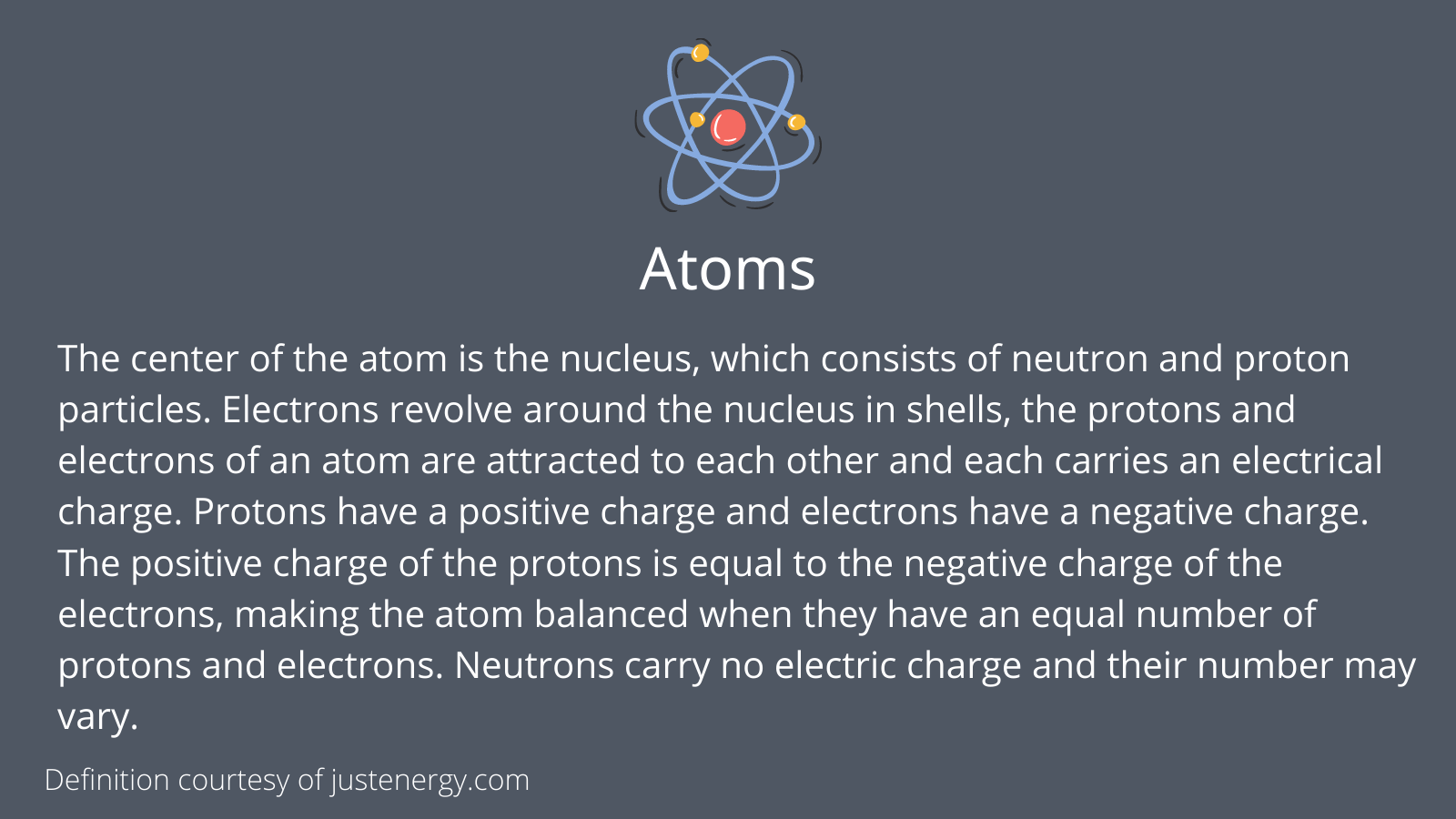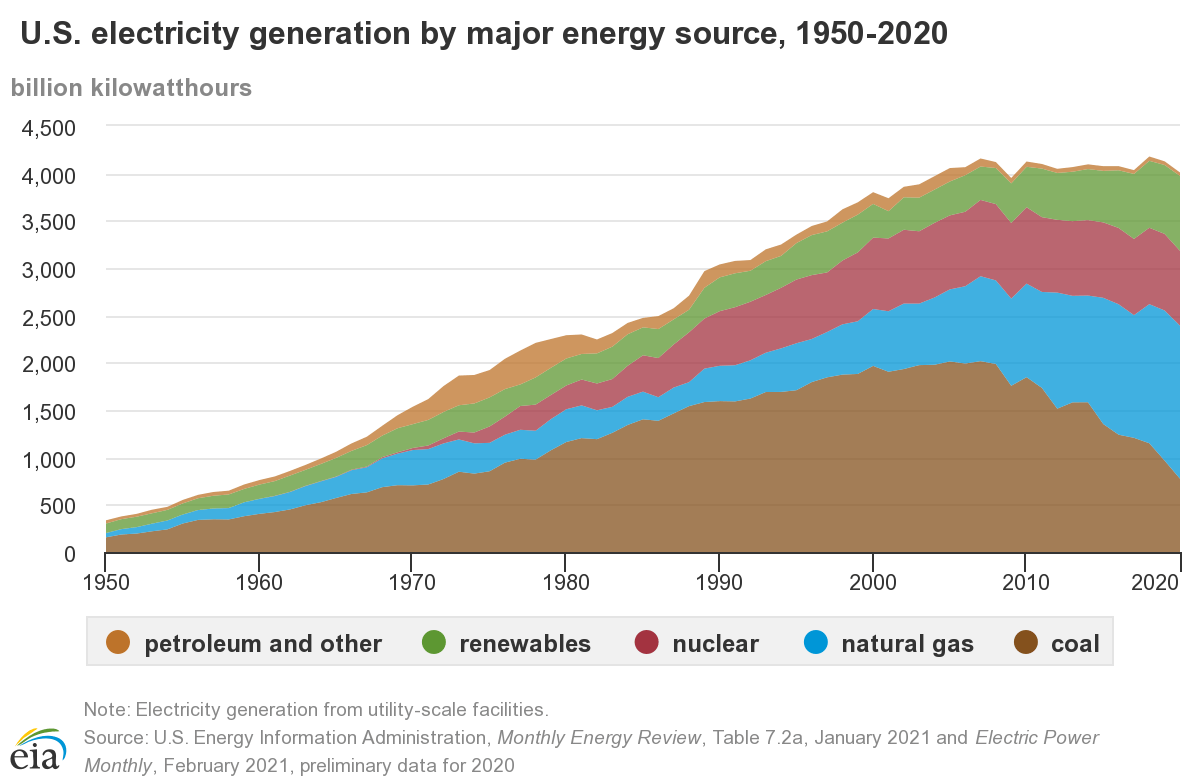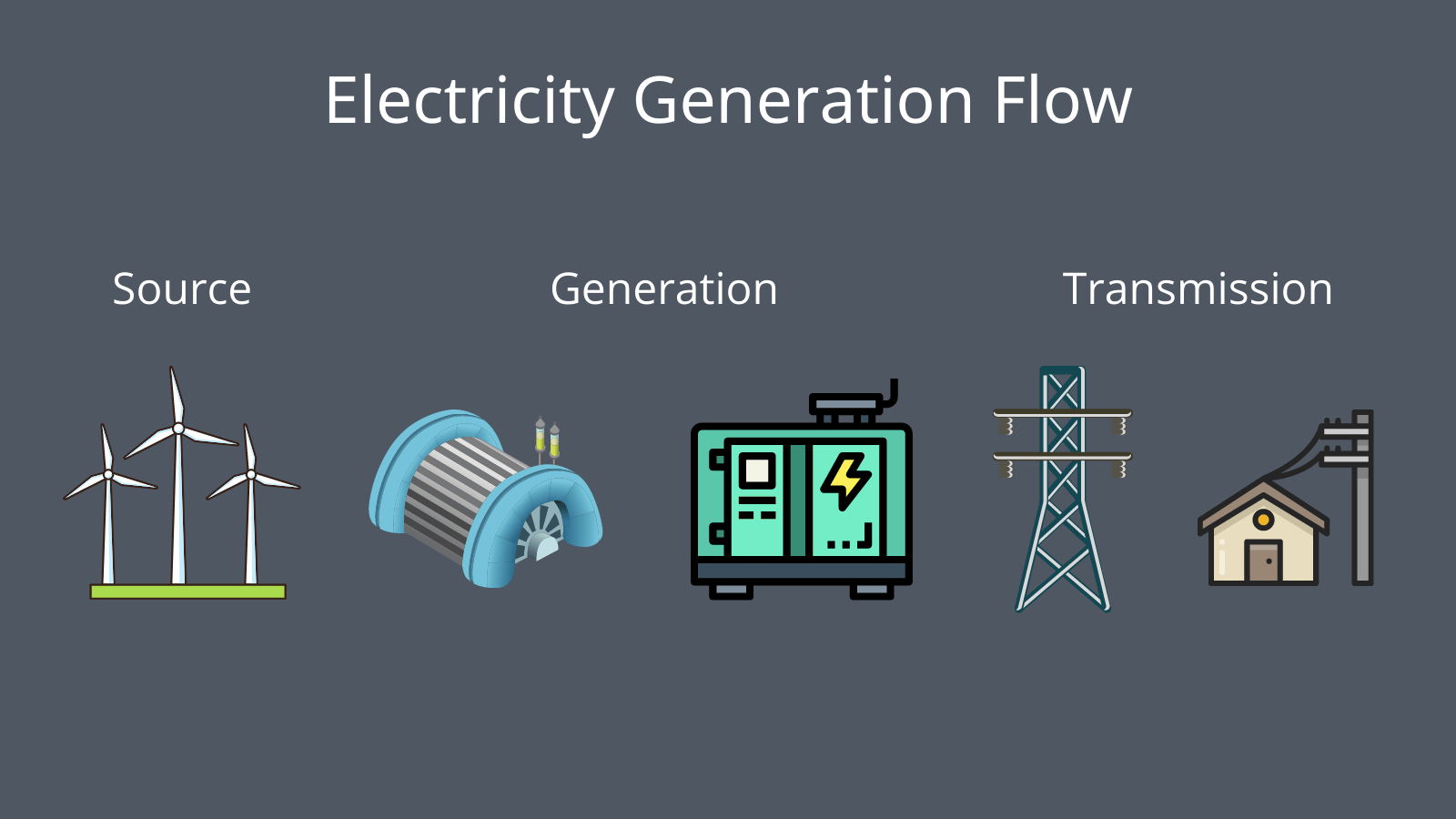Updated 11/24/2023
Consumers have begun to embrace the many forms of renewable energy despite rising environmental concerns. Investments in electricity generation are increasing tenfold, with the US spending over $120 billion in 2020 and another $550 billion expected for future growth.
We must understand electricity and its generation to invest in the renewable energy sector and the increasing demand for electricity.
Key Takeaways
- The total global electricity generated tops 26,730 TWh, with the US consuming 3,844 TWh, and expected to grow over the next 30 years, led by renewable energy.
- The primary forms of electricity generation are chemical, friction, heat, light, magnetism, and pressure.
- We measure electricity in watts, the unit of one power, and then larger units such as kilowatts, megawatts, and gigawatts.
- Most electricity generation in the US stems from steam engines, which use fossil fuels to create steam, which move blades that turn rotors over copper wires, creating electricity.
- Renewables are the fastest-growing sector in electricity generation, led by solar and wind.
In today’s post, we will learn:
- What is Electricity 101?
- How is Electricity Measured?
- What Are the Six Methods of Producing Electricity?
- How is Electricity Generated?
- How is Electricity Distributed?
Okay, let’s dive in and learn more about electricity generation.
What is Electricity 101?
Electricity is all around us; electricity powers them, whether our phones, computers, or the fridge that holds all of our food and beverages.
And now, electricity is gaining a foothold in cars, with the rise in the popularity of Tesla.
Electricity is all around; it comes in many different forms:
- Coal
- Water
- Solar
- Wind
- Hydro
- Nuclear
Have you ever wondered what electricity is, its generation, and how we have it in our homes?
Learning and understanding the basics of electricity can help us better understand potential investments and their impacts.
Electricity is the flow of an electrical charge; it is a basic part of nature and one of the most commonly used forms of energy. Think of Benjamin Franklin, flying a kite with a key at the end and lighting.
Electricity is a secondary energy source, meaning it does not occur naturally. We get it from converting other energy sources, such as coal, nuclear, solar, wind, and oil. These are primary sources of electricity.
The energy sources we use to generate electricity can be renewable or non-renewable, such as wind or nuclear, but the actual electricity is neither.
Like everything else, electricity consists of atoms, so to understand electricity better, let’s look at the basic makeup of atoms.


Electricity moves in closed circuits, with electrons needing a complete path before moving through the circuit.
It is not like water, which flows from high to low; when you open the spigot, out comes water. Instead, when you turn on a light switch, you close the circuit, allowing the electricity to “flow.” And when you turn off the light switch, you open the circuit.
Electricity flows from the wire, through the computer, and back to the wire. The same idea works for our TV, cell phone charger, or coffee maker.
How is Electricity Measured?
We all wonder this as we read our electric bills every month.

Watts ‘ power units’ main measurement of electricity is after James Watt, the steam engine inventor. A Watt is a unit of electrical power equaling one ampere under the pressure of one volt.
One Watt is a small quantity of power, with some devices only requiring a few Watts to run and others taking larger amounts of Watts to run. The power consumption of smaller devices like TVs, fridges, and computers is measured in Watts, while much larger devices measure power consumption in kilowatts (kW), or 1,000 Watts.
Measuring generation moves into multiples of kilowatts, such as megawatts (MW) and gigawatts (GW). For scaling purposes, one MW is 1,000 kilowatts or 1 million Watts. And one gigawatt (GW) is 1,000 MW or 1 billion Watts.
Electricity generation often switches between megawatt and gigawatt, so it is best to remember that 1 gigawatt equals 1,000 MW for reference.
Electricity also measures use by the amount of time used; for example, a Watthour (Wh) equals one Watt’s worth of energy continually applied to or taken from the electric circuit for one hour.
Utilities or power plants measure the amount of electricity generated in kilowatt-hours (kWh), with one kWh equaling one kilowatt consumed or generated in one hour. For example, if you turn on your lamp with a 40-watt light bulb for five hours, you have used 200 Wh or 0.2 kWh of electricity.
A great example is Brookfield Renewable Energy (BEP), the Canadian renewable energy producer. Their financials are littered with references to power generation, as seen below.

If we want to convert that to megawatt-hours, we take the 36,568 and multiply it by 1,000 and 36.5 billion megawatt-hours. That seems huge, but to put it into reference, Illinois consumed 4 billion megawatt-hours in 2020.
That means that Brookfield produced enough energy to power almost ten states of Illinois. Impressive.
What Are the Six Methods of Producing Electricity?
Electricity is not freely available from nature, so we must create it or transform other forms of energy into electricity. For utilities, that is the stage before they transmit or distribute the electricity to consumers, private or business.
There are six main methods of producing electricity:
- Chemical
- Friction
- Heat
- Light
- Magnetism
- Pressure
These different methods align with the mechanical methods we use to generate electricity.
For example, chemical occurs using lithium-ion batteries that power electric vehicles. Light refers to the photovoltaic effect that transforms sunlight into electrical energy in solar cells.
The six most common sources of electricity today are coal, natural gas, nuclear fission, sunlight, wind, and hydro. All of these sources directly relate to the methods in their generation; for example, the water pressure flowing over a dam moves the paddles, producing electromagnetic energy in the generators that create electricity.
How is Electricity Generated?
Electricity generation occurs in an electronic generator device that converts energy into electricity.
Most of the world’s electricity generation comes from generators using Michael Faraday’s discovery. In 1831, Farraday discovered that moving a magnet inside electric coils induces or makes an electric current flow through the wire.
Faraday used this discovery to create the Faraday disk, which uses the relationship between magnetism and electricity, leading to the design of the electromagnetic generators we use today.
The basic setup uses an electromagnet, not a traditional magnet. The makeup of an electromagnet includes a series of insulated coils of wire that make up a stationary cylinder called a stator. All of which surrounds the electromagnet shaft called the rotor.
Turning the rotor causes an electric current to flow through each section of the wire coil, becoming a separate electric conductor. The currents in each section combine to form one large current. That electricity moves from the generators through power lines to the consumer.
Fun fact: nearly all US electrical generation stems from electromagnetic generators using coal, natural gas, or hydro.

Most of the world’s electricity, including the US’s electricity generation, comes from power plants or utilities using a turbine to drive the electric generators.
A turbine generator uses moving fluid, water, steam, combustion gases, and air to push a series of paddles mounted on a rotor shaft. The force of those liquids pushes the paddles, causing the blades to spin the rotor shaft of the generator.
The generator converts the rotor’s kinetic (mechanical) energy into electricity.
There are different types of turbines, including:
- Steam turbines (coal)
- Combustion turbines (natural gas)
- Hydroelectric turbines (water)
- Wind turbines
The different turbines above move from dirtiest to cleanest, with coal the dirtiest, hydro and wind the cleanest, and gas somewhere in the middle.
Let’s look at the different types of turbines a little closer.
Steam Turbines
Steam turbines account for most of the world’s electricity generation, making up 44% of the US’s current generation.
Most steam turbines use a boiler, with fuel burned to produce steam in a heat exchanger, with that steam driving the turbine.
The most common forms of fuel for these types of turbines remain coal and, increasingly, natural gas. Coal is on a downward trend, while natural gas replaces coal. Natural gas is a “cleaner” fuel source but is not as clean as renewable or nuclear energy.
Speaking of nuclear, nuclear power reactors use nuclear fuel rods to generate the steam needed for electricity generation. And despite the fears surrounding nuclear energy, it is one of the better “dense” forms of energy, much cleaner than natural gas and coal, but that is a subject for another day.
Combined Heat and Power Turbines
Also known as cogenerators, these turbines operate similarly to conventional power generators that use turbines that move under steam from burning coal, natural gas, or diesel fuel.
But cogenerators also have a separate turbine that moves from outside air heated by fossil fuels.
The cogenerators operate on a higher efficiency rating than traditional steam generators. They can operate at different workload levels, making them more flexible and slightly less polluting.
Check out this link to learn more about these types of power generation.

The above groupings of generators operate using fossil fuels in shape or form; the below groups are renewable sources such as hydro, solar, and wind.
Hydroelectric Turbines
Hydroelectric turbines use moving water to spin the turbine blades to generate electricity. Most hydroelectric plants use the water stored behind reservoir dams or diverted from rivers or streams.
Think of dams like the Hoover Dam in the US as a perfect example of this type of electricity generation.
These hydroelectric generators will account for approximately 7% of electricity generated in the US in 2020.
Another form of hydro generation is the use of pumped-storage hydropower plants. These power plants use the same type of moving water running over blades to generate the power; they use the excess power to pump water into reservoir storage for later use. It is a power storage method because the stored water is released to run over the turbines, generating electricity.
Below is a cool video explaining how hydropower plants operate:
Fun fact: the top hydropower producers in the world:
- China – 356.64 GW
- Brazil – 109 GW
- US – 102.7 GW
- Canada – 81.39 GW
Another fun fact is that hydro assets are the longest-lived, with an average annual life of 100 to 125 years, compared to 25 to 30 years of solar panels.
Solar Photovoltaic Cells
Solar panels convert solar (sunlight) directly to electricity. Solar panels come as small as wristwatches and can be chained together to form large solar farms that power homes or plants.
Solar is one of the fastest-growing renewable energy sources in the consumer and commercial sectors.
In the US, solar power was responsible for around 2% of power generation in 2020, with projections estimating it will produce up to 20% by 2050.
For context, US solar jobs have grown 167% over the past decade, five times faster than the overall US job market. And in 2020, there was over $25 billion in investment in the solar industry.
Much of the growth of solar is the dropping installation prices, which have fallen over 70% in the last decade, making it far more competitive with other “normal” forms of power generation.
Wind Turbines
Wind turbines are arguably the most visible forms of power, with the large windmills towering over the landscape. Windmills have been used for power since the early 7th century and more recently used to generate power with the wind flow.
The wind turbines use the power of the wind to move the blades to the rotor, generating electricity. Wind turbines generated about 8% of the electricity created in the US in 2020.
Newer developments in the industry include offshore wind generation.
Despite the glamor of solar, wind energy is the fastest-growing renewable energy source, with over $24.6 billion of investment, and wind provides more than 10% of electricity generated in over 16 states. In 2020, the US installed 16,386 megawatts of wind generation.
There are other forms of electricity generation, such as:
- Biomass
- Geothermal
- Tidal
However, the above generation forms remain the largest players at the current time.
How is Electricity Distributed?
The majority of electricity generated distributes through utilities over the electrical grid.
Many utilities only sell power to consumers via the electricity they generate in their power plants, but many buy the power they sell to us, the consumers, particularly those who don’t have the assets to generate cleaner energy.

Utilities or power plants generate power flows to consumers over transmission and distribution power lines or cables.
Think of those tall towers carrying power lines or the smaller wooden ones in your neighborhood. Also, many power lines are beneath our feet, too.
The complex system of wires, transformers, and power stations creates the “grid,” which includes substations and other necessary equipment to bring us our electricity.
In the US, the electricity grid contains thousands of miles of high-voltage power lines and millions of low-voltage lines connected with transformers that connect the grid to utilities.
Those high-voltage power lines that hang between the large metal towers can carry electricity over vast distances. The low-voltage lines in our neighborhood transmit electricity through transformers that raise or lower voltages to adjust to different journey stages from generation to our home or business.
Investor Takeaway
The combination of hydro, solar, and wind is the leading edge of renewable energy generation worldwide. Despite creating new forms of power generation, there remain some technological challenges, mainly in electricity storage.
Renewable energy will struggle to overcome fossil fuels like natural gas until we overcome those challenges.
Solar and wind have challenges, mainly intermittently and generating too much power, which overpowers the current electric grid.
The grid is another challenge that needs some attention, but despite these challenges, the push for more renewable energy continues as the demand for more electricity grows.
The grid established around Edison’s lightbulb invention has not experienced much innovation since then. It is largely outdated and needs a serious overhaul, especially the power lines.
The future of renewables is bright. Over time, they will overtake the use of fossil fuels. Understanding the makeup of power generation and how the systems work will make us better investors.
And with that, we will wrap up our discussion on how electricity generation works.
As always, thank you for taking the time to read today’s post, and I hope you find something of value. Please don’t hesitate to reach out if I can further assist.
Until next time, take care and be safe out there,
Dave

Dave Ahern
Dave, a self-taught investor, empowers investors to start investing by demystifying the stock market.
Related posts:
- What to Know Before Investing in Solar Energy Updated 11/24/2023 Solar power, wind, and hydro are the leaders among energy investments globally, with over $175.8 billion in solar. But what do we know...
- Understanding the Electric Power Grid to Make Better Investments Updated 11/24/2023 The electric power grid is like the air we breathe; we don’t think about it much until something goes wrong. The power appears...
- Biofuel Industry Overview: Stocks to Watch (Biodiesel and Renewable Diesel) Some of the hottest renewable energy stocks which are working to fight climate change can be found in the biofuel, or biodiesel and renewable diesel,...
- Berkshire Hathaway 10Q Summary First Quarter 2020 Berkshire Hathaway reported its first-quarter earnings on May 2, 2020. This report is a summary of those first-quarter results and will not attempt any analysis...
